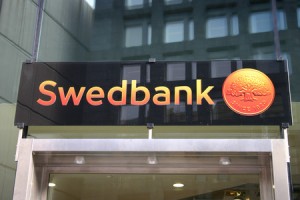S&P ups Swedbank, citing Swedish support, but sees economic risks
Dec 4th, 2015
Standard & Poor’s upgraded Swedbank to AA- on Wednesday and revised its outlook on Skandinaviska Enskilda Banken (SEB) from negative to stable, citing a belief that the Swedish government will still support systemically important banks’ senior creditors in spite of BRRD, but the rating agency also warned of heightened economic risks for Swedish banks.
 S&P said that various rating actions on eight Swedish banks reflected two key themes. Firstly, its belief that the Swedish government remains likely to provide support to its systemically important banks prior to entering a resolution process or bail-in by senior unsecured creditors, in spite of the expected implementation of the Bank Recovery & Resolution Directive (BRRD) in February 2016.
S&P said that various rating actions on eight Swedish banks reflected two key themes. Firstly, its belief that the Swedish government remains likely to provide support to its systemically important banks prior to entering a resolution process or bail-in by senior unsecured creditors, in spite of the expected implementation of the Bank Recovery & Resolution Directive (BRRD) in February 2016.
“With the implementation of BRRD, some of the government’s flexibility to provide support to the banking sector has been reduced,” S&P said. “However, in our view, the government remains clear in its political tone and actions that it intends to avoid a systemic crisis by providing pre-emptive capital support to its systemically important banks during a crisis.”
Secondly, S&P said it believes that current trends in house price appreciation in Sweden are unsustainable, seeing a resurgence in Swedish household debt as an indication that low interest rates, strong tax incentives for debt, and a persistent housing shortage are increasing economic risks.
The rating agency said there is an increased likelihood that it could revise down the anchor for Swedish banks to ‘bbb+’ from ‘a-’ unless there is a significant change in direction. S&P added that for six of the eight banks reviewed, a change in the anchor would likely lead to a lowering of the long term rating on the bank.
S&P upgraded Swedbank from A+ to AA-, reflecting its view of Sweden’s ongoing support for systemically important banks. The rating agency subsequently removed a negative adjustment notch in place since July, which reflected an expected negative transition due to the potential removal of government support. The outlook on the rating is negative, reflecting S&P’s view of heightened economic risk for Swedish banks.
The rating agency revised the outlook on SEB’s A+ rating from negative to stable, to reflect the rating agency’s view that it could revise upward SEB’s stand-alone credit profile (SACP) as it continues to generate capital, offsetting the negative trend for the banking sector, as well as the expectation of continued government support.
S&P on Friday of last week (27 November) said risk-adjusted capital (RAC) ratios of banks in the Nordic countries have continue their positive trend, with Nordic banks outperforming European peers in terms of capital and earnings metrics in spite of historically low interest rates across the region.
The rating agency said that since 2011, RAC ratios for most banks have increased by over 30%, and during the first half of 2015 alone the increase averaged approximately 7%.
“These improvements are driven primarily by steady increases in equity capital, coupled with hybrid capital issuance during the past year, which has improved the numerator; risk-weighted assets have remained relatively stable,” it said.
S&P said that, neutralising currency effects, the eight largest Nordic banks have increased total adjusted capital (TAC) by a weighted average of 33% and risk-weighted assets by only 1%, resulting in a 31% increase in these banks’ risk-adjusted capital ratios.
The rating agency added that it anticipates continued robust capital generation among the Nordic banks, but said it sees the pace of growth for their capital levels as uncertain, given the lack of clarity in future regulatory requirements regarding standardised risk weights or floors, which, it said, will continue to affect banks’ capital planning and optimisation.








